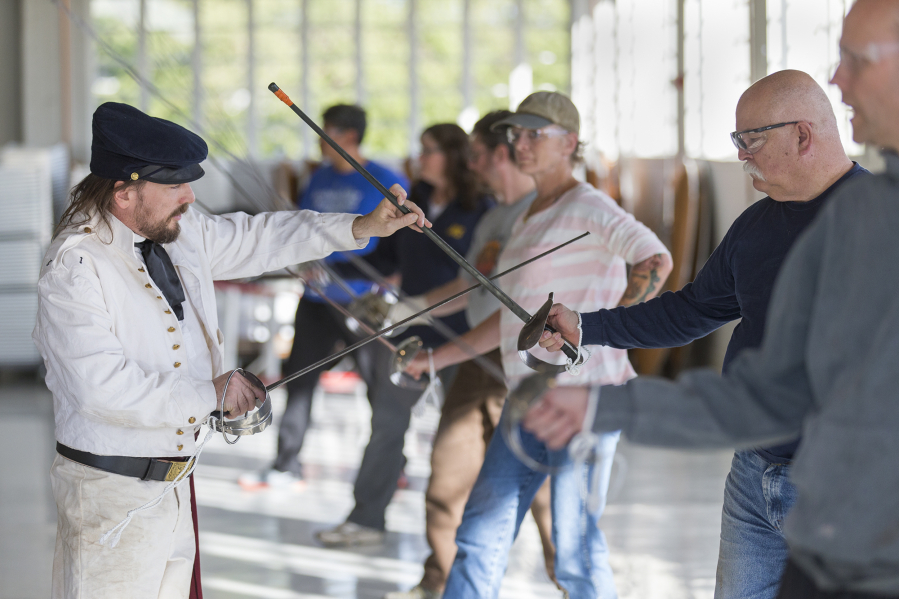For what was likely the first time in more than a century, military saber training returned Sunday to Fort Vancouver.
Trainees practiced cuts, thrusts and guards while Jeff Richardson and Elaine Dorset, dressed as contemporary dragoon detachment captain and first sergeant, respectively, ran through saber techniques.
Dorset is an archaeologist with the National Park Service at Fort Vancouver National Historic Site, and, with Richardson, organized a public training program in mid-19th century saber use at the fort. Classes started Sunday.
The training is modeled after what soldiers of the era would have received, specifically the training for dragoons, a class of infantryman who traveled on horseback and, usually, fought on foot.
Troopers with the Army’s 1st Dragoon Regiment first arrived in the Northwest, and Fort Vancouver, in 1854.
The classes go over saber techniques used the U.S. Army in that era, and include information on the history of Fort Vancouver, the dragoons and their weaponry, and how the swords fit into military tactics of the time.
Sunday’s training, in some empty hangar space at the Pearson Air Museum, was all about the basics.
Richardson said it’s not much different than learning other skills: You start with the fundamentals.
Richardson works with Academia Duellatoria of Portland, which offers training and consulting in historical martial arts, and often uses primary source documents to recreate the fighting styles of different eras.
“Most of this stuff’s not hard to find,” Richardson said. “The trick is interpreting it, because they’re military manuals and they lack a lot of details.”
Often the officers, who would train others, had to pay for additional private training themselves, on top of what the Army taught, he said.
Turnout was significantly better than expected. Richardson said they’ve added a second class each week, but still had to turn people away.
Herb Maxey, one of the participants, said he has a thing for “old stuff,” especially the Civil War era, part of why he signed up for the training.
Going further back, he graduated from San Jose State College, which, at the time, had one of the finest fencing programs in the country.
“But I couldn’t go. I didn’t have time in my schedule, and that’s something I’ve always kind of wanted to do,” he said.
He also has some background in martial arts.
“I like the discipline and the movements,” he said. “I’m a retired police officers and I’m amazed: Some of this stuff actually works into our baton training, back in the day.”
He’s planning on keeping with it, and said he’s considering staying on as a re-enactor.
“Its just interesting how the moves are designed to protect your body,” he said. “If you do it right, you’re protecting your hand and your body and all that other good stuff.”
Brett Roth, a guide at the park and part of its historical weapons program, said the park hopes to integrate the saber drills into its interpretive offerings, namely those about the fort’s early history as a military base, after the Hudson’s Bay Company had left.
The park service includes black powder and antique firearms demonstrations, and Bob Cromwell, the chief of interpretation at the park, said it hopes to add saber drilling come next summer.
“What we’re hoping for is to actually have a trained cadre of volunteers who would be willing to participate in interpretive demonstrations of saber drills of the 19th century, to show what the troops at the Vancouver barracks probably would have been trained in.”
Dorset said part of what gave her the idea for saber drills is the fact so many people always ask the fort blacksmith if they made swords.
“People are so fascinated with swords,” she said.
Beyond that, however, creating more ways to display the fort’s military history helps people connect with its past, she said, since the military was so weaved into daily life at the site.
“It was just such a huge part of the soldiers’ life. If we’re not representing that, then we’re not truly telling people and showing people what it was like to be a soldier living in that time,” she said. “It’s a story that needs to be told.”




